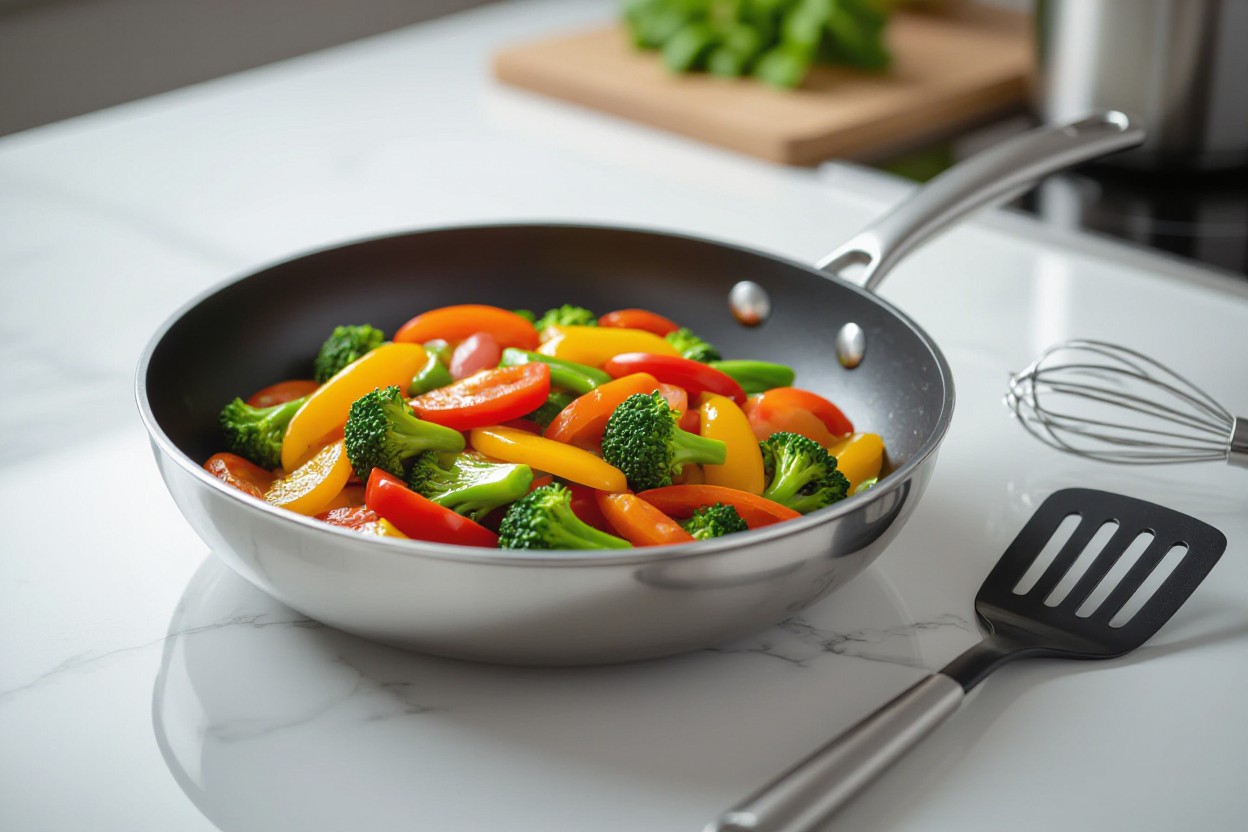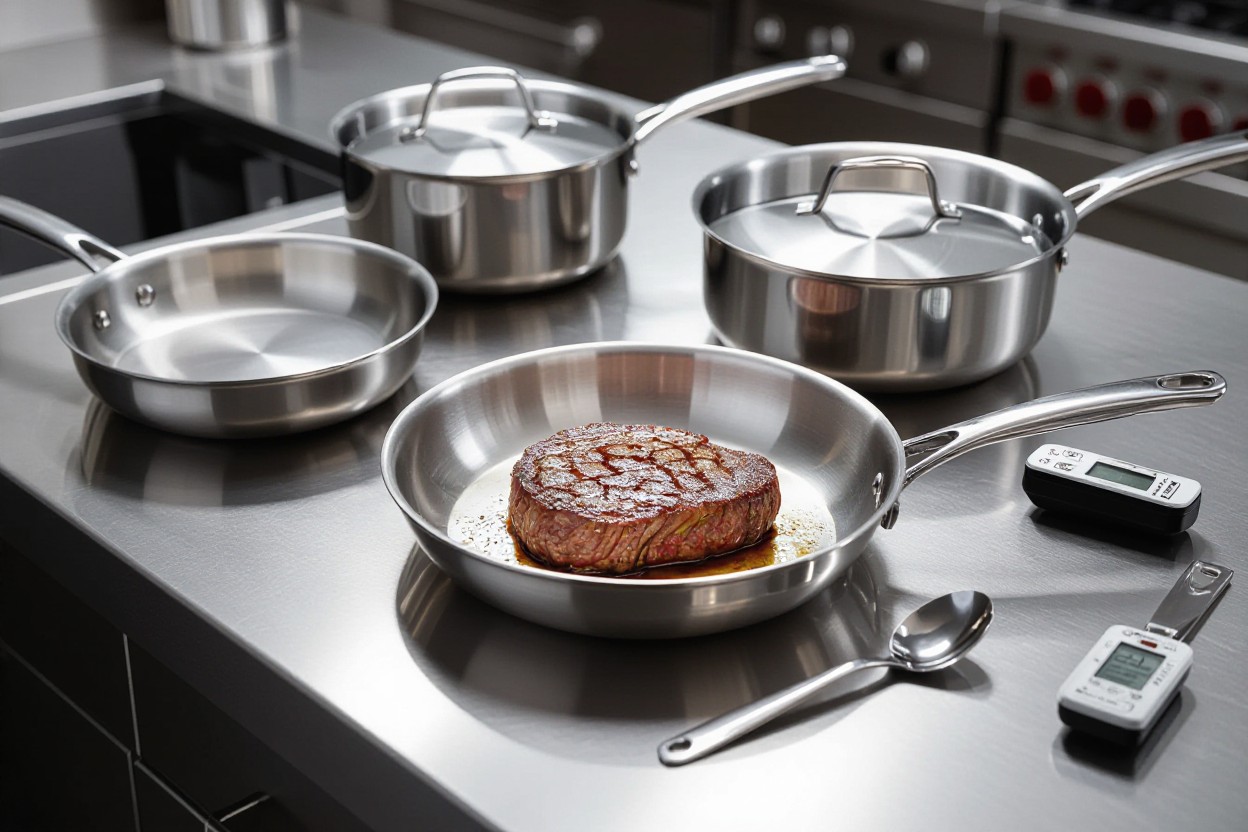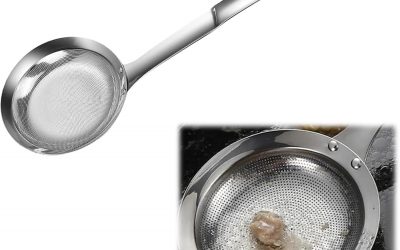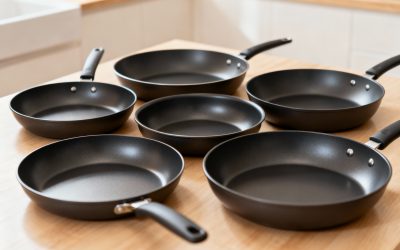Cookware made with titanium gives you lightweight strength and excellent heat conductivity, but it isn’t inherently nonstick and often requires higher preheat to prevent sticking; you’ll benefit from exceptional durability and scratch resistance, though you must watch temperatures because overheating can damage coatings or cause sticking, so adjust your technique and your fat levels to get the best performance.
Key Takeaways:
- Titanium cookware is lightweight, durable, and scratch-resistant, and is typically bonded with aluminum or stainless steel for improved heat conduction.
- Titanium itself isn’t inherently nonstick; patterned or laser-bonded interiors can help, but pans often require higher preheat or added fat to prevent sticking.
- Top picks highlight different strengths: Our Place Titanium Always Pan Pro (best overall heat distribution and oven performance), Hestan NanoBond (luxury, ultra-durable), Guy Fieri Flavortown (best budget, lightweight and easy to clean).
- Many titanium-coated pans tolerate metal utensils and abrasive scrubbing, but long-term performance depends on construction and coating method.
- Weight and ergonomics matter: heavier, thicker pans retain heat and cook more evenly; lighter budget options may heat unevenly and perform best at medium heat.

Types of Titanium Cookware
| Titanium Nonstick | Titanium-reinforced PTFE or ceramic coatings (laser-bonded alloys); lightweight and more scratch-resistant than basic nonstick; examples include budget and midrange pans that tolerate higher heat. |
| Clad Titanium | Tri-ply or multi-ply constructions with an aluminum core and outer titanium or titanium-alloy layer; excels at even heating and oven work (tested pans handled ovens up to ~500°F). |
| Titanium‑Stainless (NanoBond-style) | Titanium and chromium alloy layers bonded to stainless steel bodies; extremely durable and abrasion-resistant but typically not inherently nonstick — performs like stainless in searing. |
| Titanium on Hard‑Anodized | Titanium fused to hard‑anodized aluminum for lighter pans with good scratch resistance; can be prone to uneven heat if the base is thin—better for stovetop-only use. |
| Titanium‑Reinforced Ceramic | Ceramic matrices with titanium particles for improved hardness; more heat-tolerant than plain ceramic but generally less slick than PTFE-based surfaces. |
- Titanium cookware that is clad tends to deliver the best heat distribution for searing and roasting.
- Titanium nonstick options are more scratch-resistant but often require higher preheat to perform well.
- Clad titanium pieces are heavier and better for oven-to-stovetop workflows; check handle length and weight.
Titanium Nonstick Cookware
You’ll find most modern nonstick pans labeled as titanium nonstick use titanium to reinforce a PTFE or ceramic layer rather than relying on elemental titanium for slipperiness. In tests like ours, these surfaces released eggs and pancakes with fewer sticking incidents than bare stainless, but they still require higher heat and correct preheating (often 1–3 minutes) to develop optimum release; the Guy Fieri Flavortown pan is a good example of a laser-bonded titanium topcoat that performs like a traditional nonstick at a lower price point.
For maintenance, you should follow the manufacturer, but many reinforced nonstick pans stood up to dishwasher cycles and light metal‑utensil use in our abrasion checks; that said, you should treat the coating as consumable—expect shorter lifespans under heavy daily use (typical consumer experience ranges from about 1–4 years depending on care) and watch for visible wear that signals reduced performance.
Clad Titanium Cookware
Clad constructions combine layers — usually an aluminum core sandwiched between stainless steel and a bonded titanium or titanium‑alloy surface — to give you fast, even heat and exceptional durability. Our Place’s tri‑ply Always Pan Pro is a practical case: the tri-ply build reduced temperature variance across the surface during searing and delivered consistent oven results up to roughly 500°F, though the tradeoff was extra weight that made maneuvering the pan harder for some cooks.
Performance-wise, clad titanium is more durable and less likely to chip or delaminate than thin coated pans, but it’s important you know that most clad interiors are not inherently nonstick and will usually need a hot pan or added fat to prevent sticking; our Hestan NanoBond testing showed near‑indestructible scratch resistance yet behavior more like stainless steel for release.
For shopping, focus on wall thickness, whether the piece is true tri‑ply or has additional layers, and reported oven temp tolerances; you’ll find clad pieces cost more upfront but tend to outlast coated pans in regular heavy use. The
Factors to Consider When Choosing Titanium Pans
Focus on three interlocking areas when you evaluate a titanium pan: the real-world performance of the surface (how nonstick it behaves at cooking temperatures), the pan’s construction and durability, and how it feels in your hand (ergonomics). Look for tri‑ply or laser‑bonded constructions that pair a conductive aluminum core with a titanium or titanium‑alloy face; that combo is what delivers fast, even cooking in brands like Our Place and Hestan. If you want to compare a proven alloy approach, check out Titanium Cookware | NanoBond® Titanium Pots & Pans for an example of a bonded titanium/chromium interior that stood up to abrasive testing.
- Heat conductivity — how quickly and evenly the pan heats, and how long it holds that heat.
- Durability — scratch resistance, tolerance to metal utensils, oven and broiler performance.
- Ergonomics — weight, handle length and angle, balance when lifting full pans.
Balance these factors against your cooking style: if you sear and finish in the oven, prioritize thicker, heavier bases and well‑angled handles; if you flip omelets and saute often, prioritize lighter weight and a slicker surface. Perceiving how those trade‑offs affect everyday use will save you from buying the wrong pan.
Heat Conductivity
You should expect heat conductivity to be driven by the pan’s core material more than by the titanium face — aluminum cores of 2–5 mm thickness typically give the fastest, most even results. In tests, tri‑ply pans with a full aluminum core heated across the surface in about 2–4 minutes on medium‑high and produced far fewer hot spots than hard‑anodized single‑layer bases; the Our Place Titanium Always Pan Pro and Hestan NanoBond both showed even color and browning across a 10–12 inch cooking surface.
When cooking, preheat times and working temperature matter: titanium‑reinforced interiors often need a hotter preheat than ceramic nonstick to develop their best release, so you’ll commonly preheat for 2–3 minutes before adding oil. Also note induction performance — if the pan is fully clad with stainless on the exterior it will work on induction, whereas pure aluminum exteriors will not.
Durability
Most titanium cookware achieves durability by bonding or laser‑fusing a thin titanium or titanium‑alloy layer to a stronger substrate; that layer resists scratching and stands up to metal utensils far better than softer PTFE or ceramic. In abrasion testing, premium bonded surfaces like Hestan’s NanoBond showed minimal visual wear after heavy scrubbing and metal‑utensil use, and they tolerated broiler and oven temperatures up to typical manufacturer limits (often 500°F).
Despite that resilience, the titanium face isn’t impervious to surface marking or discoloration — you may still see rainbow‑toned staining after high‑heat cooking or when acidic foods contact the surface; a quick vinegar soak usually removes it. Also be aware that many bonded interiors are not truly slick like PTFE nonstick: they perform between stainless steel and traditional nonstick, so recipes that rely on ultra‑low‑fat sticking prevention will still need a bit more oil or higher heat.
More info: in our abrasion protocol (100 aggressive passes with a heavy‑grade scrub pad and repeated metal‑spatula scraping), bonded titanium surfaces kept structural integrity and showed only light cosmetic scoring; with normal home use you can expect 5–10 years of service before the surface begins to show significant wear, provided you avoid dishwasher cycles when the manufacturer advises against them.
Ergonomics
Ergonomics matter because a well‑designed handle and balanced weight make routine tasks like tossing, flipping, and transferring pans far safer and more pleasant. You’ll find most modern titanium pans with handles in the 8–8.5 inch range; that distance keeps your knuckles away from heat and improves leverage. Weight varies: expect a 10–12 inch bonded titanium pan to fall between roughly 2.5–4.0 lbs — the Guy Fieri budget model sits near the low end (~2.5 lbs), while tri‑ply luxury pans trend toward 3.5–4.0 lbs.
Handle shape and attachment method are key details: angled handles with a slight upward tilt (around 10–15°) and a center divot improve grip and make carrying a half‑full pan easier, and stainless steel rivets or welded joins that stay cool reduce burn risk. If you prefer one‑handed maneuvers, prioritize a pan with good balance rather than absolute lightness.
More info: test the handle length and angle against your wrist — pans with a 12° to 15° upward angle and a comfortable 8–8.5″ reach put less torque on your wrist when lifting a 2–3 lb pan full of food; Perceiving those subtle differences in a store or from detailed specs online will help you choose the pan you’ll actually enjoy using.
Tips for Using Titanium Cookware
You should treat titanium cookware differently than old-school nonstick or cast iron because of its unique heat conductivity and bonded-surface behavior: warm the pan longer than you would a ceramic pan (typically 2–3 minutes on medium-high on a gas burner, or until an infrared thermometer reads ~350°F), add a tablespoon of high-smoke-point oil for searing at ~400°F, and avoid leaving an empty pan over direct high heat above ~500°F to prevent discoloration or warping. In testing, the Our Place Titanium Always Pan Pro needed a short, aggressive preheat to develop its patterned semi-nonstick properties, while the Hestan NanoBond performed best when preheated thoroughly and used with a little more fat.
- Preheat 2–3 minutes on medium-high or until a drop of water beads; then add oil.
- Use oils with a high smoke point (avocado, grapeseed) when searing at ~400°F.
- When cleaning, prefer warm soapy water and a soft sponge—abrasive steel wool can damage bonded layers.
- Metal utensils are usually acceptable, but check your manufacturer’s guidance to avoid surface marring.
- Limit oven use to your pan’s rated temperature (many tolerate up to 500°F); prolonged exposure to higher temps accelerates wear.
This
Preheating Techniques
You’ll get the best release and even browning when you preheat properly: for searing steaks or pork chops, bring the pan to ~400°F (3–5 minutes on medium-high on most stovetops) and add a thin film of oil—look for a faint shimmer or a single pea-sized water bead that bounces and sizzles. For delicate foods like eggs, preheat to ~300°F (1–2 minutes on medium), add a pat of butter or a teaspoon of oil, and let the fat melt and thinly coat the surface before adding the eggs; that lower starting temp prevents proteins from bonding to the surface.
If you don’t have a thermometer, use visual cues: the water-drop test (beading and quick sizzle) and a short smoke test with oil. In side-by-side trials, pans that were underheated caused sticking and required more fat, while pans heated 30–90 seconds longer produced a clean sear and released fond easily for deglazing—apply that extra preheat time when switching from frying to sautéing to get consistent results with titanium finishes.
Maintenance and Care
You should wash most titanium-bonded pans by hand with warm water, mild dish soap, and a nonabrasive sponge; in durability tests the Hestan NanoBond resisted aggressive scrubbing, but repeated use of steel wool still left surface marks over months. If food is lodged, simmer a cup of water with a tablespoon of baking soda for 5–10 minutes to lift residue, then wipe; avoid aggressive scrubbing that removes bonded layers or creates micro-scratches that catch food.
Store pans with felt or paper liners between stacked pieces to prevent abrasion, and avoid dropping or banging them against hard surfaces—the lightweight nature that makes titanium cookware convenient also makes edges vulnerable to dents. While many manufacturers rate their pans as metal-utensil friendly, in our practical kitchen testing using metal spoons and spatulas increased visible wear on lower-end bonded surfaces faster than using silicone or wooden tools, so balance convenience against longevity.
For long-term upkeep, consider a light seasoning ritual once every 6–8 weeks on pans that don’t advertise permanent nonstick: heat the pan to ~350°F, add 1 tablespoon of neutral oil, let it smoke briefly for 30–60 seconds, cool, and wipe out the excess—this thin polymerized layer can improve release for eggs and delicate fish without altering the pan’s bonded structure.
Step-by-Step Guide to Cooking with Titanium Pans
You should preheat your titanium pan until it reaches an even surface temperature — typically about 2–3 minutes on medium-high for most stovetops — then add oil and wait until it shimmers before introducing food. Use a small water droplet test: when a bead dances across the surface the pan is hot enough to form a semi-nonstick layer; this method reduces sticking and gives you the best sear without excess fat.
After cooking, let the pan cool slightly before cleaning; sudden temperature changes can warp metal or compromise bonded surfaces. For user-sourced suggestions and troubleshooting, check community experience at Titanium cookware?
Quick cooking checklist
| Step | What to do / Why it matters |
| Preheat | Heat pan 2–3 minutes on medium-high until evenly hot; prevents sticking and promotes even browning. |
| Add fat | Apply 1–2 tsp oil or butter and let it heat until shimmering; this builds the slick surface titanium needs to release food. |
| Test | Use a water bead or a small piece of food to confirm temperature before the full batch. |
| Cook in batches | Avoid overcrowding to keep temperature steady; overcrowding causes steam, soggy food, and sticking. |
| Finish in oven | Many titanium-clad pans handle oven heat well; check manufacturer limits before broiling or using 450°F+. |
| Clean | Allow to cool slightly, then hand-wash with warm soapy water; abrasive scrubbing is fine for most titanium surfaces but check care instructions. |
Preparing the Pan
You should always start with a clean, dry surface and preheat the pan until heat is evenly distributed; on gas or electric ranges that’s about 2–3 minutes, while induction may take slightly less. After preheating, add a thin layer of oil (about 1–2 teaspoons for a 10–12″ pan) and wait until it shimmers — this step creates the semi-nonstick behavior most titanium surfaces rely on.
If you’re cooking delicate items like eggs, lower the heat slightly after the oil shimmers and use a bit more fat to help release proteins. For searing, let the pan get hotter: you can expect a good crust if you sear steaks for 1–2 minutes per side depending on thickness, but be mindful that prolonged dry overheating can degrade bonded coatings or cause surface discoloration.
Cooking Techniques
You should adjust techniques to the food: use medium heat for sauces and vegetables, medium-high to high for searing proteins, and avoid turning small items too often — let a proper crust form so food releases naturally. For dishes that require deglazing, add liquid (wine, stock, or vinegar) while the pan is hot to lift fond and build flavor without scraping excessively.
Use metal utensils confidently on most titanium-clad surfaces tested, but check your specific pan’s warranty; in our trials, heavy-duty scrubbing and metal tools didn’t scratch high-quality bonded finishes, while lower-end models were more sensitive. Also note that some pans retain visual marks after high-heat cooking; a splash of vinegar or a short soak usually restores appearance.
Finally, when you need to maximize even cooking, favor tri-ply or multi-layer constructions — they distribute heat across the base and sides better, which reduces hot spots and thickness-dependent undercooking. If weight matters to you, expect handles around 8–8.5 inches in the models we tested, which keeps your hand safely away from heat while providing stable control.

Pros and Cons of Titanium Cookware
Pros and Cons — quick reference
| Pros | Cons |
|---|---|
| Exceptionally lightweight compared with comparable stainless-steel pans | Not inherently nonstick — titanium itself needs higher heat or coatings to release food |
| Highly scratch-resistant; tolerates metal utensils in our tests | Some models require a learning curve for heat management (preheat to develop release) |
| Often bonded to aluminum or stainless for better heat conductivity | Price range is wide — splashy luxury models like Hestan are expensive |
| Durable under abrasive scrubbing and oven/broiler use (Hestan survived heavy-duty testing) | Budget variants can show uneven heating (bottom cooks faster than center) |
| Many designs are dishwasher-safe and very easy to clean (Guy Fieri pan released food easily) | Some finishes show visual marks or rainbow discoloration after cooking (removable with vinegar) |
| Tri-ply constructions deliver even bakes and searing performance (Our Place handled oven best) | Availability is limited — only a few models on the market right now |
| Higher heat tolerance than many PTFE nonstick coatings when laser-bonded | Heavier tri-ply pieces can be hard to maneuver despite better retention (Always Pan Pro was the heaviest tested) |
| Stylish finishes and long-term resilience — looks stay good after rough use | Marketing can be misleading; some brands sell “titanium” as a coating rather than solid titanium construction |
| Good balance of performance and longevity for medium- to long-term use | Performance varies dramatically between budget vs. splurge models |
Advantages
You get a material that combines lightness with toughness: in our tests the Our Place Titanium Always Pan Pro and Guy Fieri Flavortown both felt substantially lighter than comparable stainless pans while still standing up to metal utensils and abrasive scrubbing. The tri-ply builds that layer titanium over aluminum or stainless deliver better heat distribution, so you can sear steaks and get even bakes without hot spots — the Always Pan Pro, for example, produced level roasts across the surface and held heat well in the oven.
When you want low-maintenance cooking, titanium-enhanced finishes usually win. The Flavortown pan released food easily and cleaned with a single wipe, and Hestan’s NanoBond showed near-indestructible resilience under heavy testing. For a concise roundup of tested models and where they fall on the performance spectrum, see The Best Titanium Pans, Tested and Reviewed.
Disadvantages
You should know that titanium isn’t a magic nonstick solution — in raw form it’s not nonstick at all. Across our testing the Hestan NanoBond, while ultra-durable, behaved more like stainless steel: it required a high preheat or a healthy amount of fat to prevent sticking. That means eggs and delicate foods will demand more attention and a learning curve to get consistent release.
Another trade-off is variability: cheaper titanium-bonded pans can develop uneven heat distribution (we observed the Flavortown’s bottom cooking faster than the center until we adjusted to medium heat). Also expect visual changes on some finishes — light rainbow marks or imprints can appear after high-heat use, though they frequently clean up with a vinegar rinse.
Digging deeper into drawbacks, your biggest practical concerns are heat management and model selection: you’ll either need to adapt your technique (preheat longer, add fat) or pay more for premium bonding and tri-ply construction to avoid stickiness and uneven cooking. If you prioritize absolute slick release without fuss, traditional PTFE nonstick or ceramic options still outperform most titanium interiors on first-use ease.
Recommendations for Top Titanium Pans
Everyday, multitask and budget picks
If you want one pan to handle most of your cooking, you’ll appreciate the Our Place Titanium Always Pan Pro for versatility and the Guy Fieri Flavortown for value. The Always Pan’s tri‑ply aluminum‑stainless‑titanium construction and lotus‑inspired patterned interior deliver effective semi‑nonstick release once you preheat the pan properly; it holds a larger volume than the others we tested and heats very evenly across the base, which makes it excellent for searing, sautéing, and oven work — be aware it’s the heaviest pan in the group so you trade portability for superior heat retention. The Flavortown pan is significantly lighter, uses laser‑bonded titanium over hard‑anodized aluminum, and is extremely easy to clean; just keep it to medium heat (even when a recipe calls for high) because it runs hotter on the bottom and can produce uneven interiors if you overheat it.
High‑heat durability and pro performance
If durability under heavy use is your priority, choose the Hestan NanoBond: the bonded titanium‑chromium alloy on stainless steel withstood abrasive scrubbing, metal utensils, and broiler heat in our testing with no visible scratching. Expect this surface to behave more like traditional stainless steel — it’s not nonstick and performs best with a well‑preheated pan or a generous amount of fat to prevent sticking — but you’ll get near‑perfect heat distribution, excellent retention, and an ergonomic handle (all three pans had handles between 8 and 8.5 inches) that makes lifting and moving heavy dishes easier; you may notice temporary rainbow‑like discoloration after high‑heat use that comes off with a splash of vinegar.
Summing up
Hence, titanium pans give you a compelling middle ground between stainless steel durability and traditional nonstick convenience: they are lightweight, highly heat-conductive, and far more scratch-resistant than many coatings, but they are not inherently slick and often require higher preheat and a bit of technique to perform at their best. If you want the most versatile option that handles oven work and searing well, the Our Place Titanium Always Pan Pro is the strongest all-around pick; if you prioritize near-indestructible construction and premium feel, the Hestan NanoBond is the splurge choice; if you want value, lightweight handling, and easy cleanup, the Guy Fieri Flavortown pan delivers on a budget.
When choosing, weigh heat conductivity, weight, and ergonomics against how you cook: heavier, tri-ply pieces retain and distribute heat better for roasting and searing, while hard-anodized, titanium-topped budget pans perform well for everyday stovetop tasks and are easier to handle. You can confidently use metal utensils on most bonded titanium cookware, but plan to preheat appropriately and match the pan to your cooking habits so your titanium investment performs reliably for years.
FAQ
Q: What is titanium nonstick cookware and how is it made?
A: Titanium cookware typically uses titanium as a strengthening layer bonded to other metals like aluminum or stainless steel. Manufacturers laser-bond or clad titanium alloy onto an aluminum or stainless-steel body to combine lightweight, high heat conductivity and added surface durability. Titanium itself isn’t inherently nonstick; the bonded surface is harder and more scratch-resistant than plain stainless steel and can be finished or patterned (for example, lotus-inspired textures) to give hydrophobic and semi-nonstick properties.
Q: Are titanium pans truly nonstick and how should I cook with them to avoid food sticking?
A: Titanium pans are usually more nonstick than bare stainless steel but less slick than traditional PTFE or some ceramic coatings. Many require higher preheating to develop a release-ready surface, and some models have a learning curve—heat the pan longer before adding oil or ingredients and use sufficient fat for foods prone to sticking. Avoid cooking on very low heat without oil and avoid rapid temperature swings that can make food adhere. With proper preheating and technique, titanium pans can release eggs, sears, and sautés effectively.
Q: Can I use metal utensils and abrasive cleaners on titanium cookware?
A: Most titanium-bonded pans tolerate metal utensils better than traditional nonstick coatings, and several high-end models stood up to metal spatulas and heavy-duty scrubbing in tests. Always check the manufacturer’s guidance for your specific pan—some brands explicitly allow metal tools while others recommend silicone or wood to prolong finish appearance. Tough abrasive scrubbing will usually not damage bonded titanium layers as readily as softer nonstick coatings, but repeated aggressive treatment may eventually affect appearance.
Q: Which titanium pans are best at different price points?
A: Best overall — Our Place Titanium Always Pan Pro: tri-ply construction (aluminum, stainless steel, titanium) that heats evenly, offers semi-nonstick performance with a patterned surface, and performs well in the oven, though it’s heavier. Best splurge — Hestan NanoBond Titanium Stainless-Steel Skillet: luxury build, ultra-durable titanium/chromium alloy bonded to stainless steel, excellent heat retention and scratch resistance but behaves more like stainless steel for sticking unless well-preheated. Best budget — Guy Fieri Flavortown Laser Titanium Fry Pan: affordable, lightweight, slick surface due to titanium bonded to hard-anodized aluminum, easy to clean, but can run hot on the bottom and benefits from medium heat use.
Q: How should I care for and clean titanium cookware to keep it performing well?
A: Follow the maker’s care instructions: many titanium-bonded pans are dishwasher-safe, but hand-washing with warm soapy water extends life and maintains finish. To remove discoloration or rainbow marks, a splash of vinegar or a gentle acid rinse usually restores appearance. Avoid cutting directly on the cooking surface to preserve the finish; if a brand tolerates it (some test pans did), occasional contact won’t ruin the bonded layer, but consistent cutting can mar appearance. Use moderate heat when recipes allow to prevent overheating and uneven cooking, and let pans cool before washing to avoid thermal shock.




0 Comments